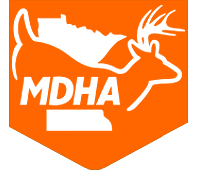
- Tom Rusch
- From Whitetales
- Hits: 10754
100 Years of Hunting Minnesota Whitetails
- Tom Rusch
- From Whitetales
- Hits: 10754
An old hunting buddy of mine pulled up in his pickup last spring when he saw me snowshoeing out of the woods on a sunny March day. He cut right to the chase as his window cracked open, “WHERE THE BLAZES ARE THE DEER?!” I shook my head and said “We might as well be chasing white elephants!”
To background, our Minnesota deer hunting tradition goes back well over 100 years. Although, the whitetail is a resilient animal adapting to a wide range of habitats and land use across the state of Minnesota, the white-tailed deer population is like a roller-coaster…it goes up and down in exasperating to we hunters’ cycles. And, like it or not, hunters are just along for the ride.
Minnesota’s deer herd continues to change, in both time and place, due to a multitude of factors driving both abundance and distribution. As we sit in the deer stand, it’s easy to think every hunter shares our pain when nothing comes down the trail.
Over the last century the most critical factors affecting the state-wide deer population in Minnesota boil down to: habitat (farming, logging/forest management, land use/management, precipitation, length of growing season, soil fertility, land development, and climate); winter/snow depth; hunting (antlerless deer harvest/regulations); disease (CWD, EHD, TB); and predation (wolf, bear, coyote, bobcat).
The annual deer harvest, sorted by decade, illustrates how deer harvest has changed significantly over time from 1920-2023. (see graph #1)

From 1920-1929, recreational deer hunting was in its infancy after World War I. The “heyday” of white pine logging was drastically changing the Minnesota landscape for both people and white-tails. Clear-cutting, land clearing for agriculture and development created a patchwork of aspen, birch and brush where pine, spruce, cedar and fir once dominated the forested part of Minnesota. These were the historically leanest years for white-tailed deer. The deer seasons, in fact, were closed in 1923, 1925, 1927, and 1929.
Deer browse was plentiful following logging and fire in the early 1920s, 1930s and 1940s. But, deer populations fluctuated, based on the severity of the winters. Critical winter cover had been logged off in the north. Deep snow winters decimated the herd and subsequently deer harvest dwindled the following year(s). There were no “bucks only” seasons to protect does. Hunters were generally not selective and shot the first deer that came by for the meat. Wolf and black bear populations were very low at this time, so predation was a minor mortality factor.
Deer populations were very low or non-existent in southern and western Minnesota due to habitat loss and unregulated hunting. Small farm agriculture dominated the prairie landscape. Hunters killed less than 40,000 deer state-wide until the 1940s. Although many people hunted, hunter numbers were low compared to today. Deer seasons were often on an every other year basis to allow for continued population growth and range expansion.
Hunters harvested 75,000 deer for the first time in 1942 and 90, 000 in 1946. The 1940s were historically mild winters with little snow. With the combination of milder winters, conservative harvest, small farm agriculture and regenerating forests, whitetails flourished. The season was only closed in 1939 and 1941.
During the 1950s, the season was closed only in 1951, for the first time in 10 years. In 1959, the harvest broke the 100,000 deer milestone for the very first time with 104,000 after 40 years of recreational deer hunting. And harvest exceeded 100,000 in 8 of 10 years from 1959-1968. In 1965, the harvest set a record at 128,000. These were landmark years. It was the pinnacle season of the first 50 years of modern deer hunting. Deer hunters were enjoying the results of a perfect storm. Regenerating forests in the north, recovering deer herds in the agricultural part of Minnesota (small dairy, pastures and small grains), and predators were limited to the far north.
Hunter numbers also grew exponentially after World War II and the subsequent baby boom. Times were good. Access to deer country continually improved as roads and highways were built and improved. Deer camps and hunting traditions were established across Minnesota from Bemidji to Ely to Winona to Alexandria. Firearms seasons were 9-days long and generally very “liberal” with “either sex” seasons the rule.

The Grim Reaper
All good things come to an end, however, and so did this era. The winters of the late 1960s and early 1970s were brutal throughout the upper Midwest including Minnesota. Old Man Winter dealt a severe blow to the herd. Five deep snow winters in a half dozen years back-to-back-to-back wreaked havoc on wintering deer and crippled the population. Fawn production was poor for many years. Forests were now middle-aged stands of pole-timber and produced limited browse and forage across deer range.
Statewide, deer numbers crashed. Without adequate fawn production, the deer population and harvest tanked. Without a way to limit doe harvest, the Minnesota legislature closed the deer season in 1971. The herd had hit rock bottom. In the 1970s just 30-75,000 deer were registered annually. A combination of severe winters, aging forests and high antlerless deer harvest stunted herd recovery. The epic deer decline occurred despite the wolf population at historic low levels.
Habitat + Mild Winters = Herd Recovery
In 1980, with the inception of the Minnesota Deer Hunters Association, deer hunters joined forces and pushed for change. With MDHA’s urging and the support of deer hunters, the MN DNR and legislators, the “doe tag” lottery was implemented to protect the breeding segment of the population following severe winters. From this push, deer habitat improvement was also implemented on a statewide scale. Then, fortunately, winters moderated. The aspen harvest boom also began in the 1980s and the deer herd responded and harvest recovered. An average of 125,000 deer were killed yearly in the 1980s and 180,000 in the early 1990s despite growing wolf and bear populations.
As nature is apt to do, historically back-to-back winters returned in 1996 and 1997. The deer herd crashed again, but this time it bounced back in just three years! The difference was a forest with excellent deer habitat across the board. Deer had a mix of young, middle-age, and older forests providing both food and cover the year around (winter, spring, summer, and fall). Wolf and bear predation were significant during this era, but deer still recovered quickly despite this predation with excellent fawn production year in and year out for the next 10-12 years.
The herd was so productive at this time bag limits were implemented in 2003 to drastically increase antlerless deer harvest throughout Minnesota’s deer range. Bonus deer permits were issued over-the-counter and up to five does could be killed in many permit areas to curtail unsustainable population growth. The MN record deer harvest was set in 2003 with 290,525 deer (120,734 bucks, 169,791 does). Nine consecutive seasons exceeded a harvest of 200,000 deer, even with a fully recovered wolf and bear population. Five consecutive years exceeded 250,000. The heyday of the second 50 years.
The Grim Reaper Returns
The winters of 2012-13 and 2013-14 were the beginning of the end of this era. Those were the most recent “good old days” in Minnesota. The boom and bust cycle had once again reared its ugly head. An unprecedented 7 of our last 11 winters have been moderately severe or worse. Winters are now statistically milder, yet snowier. The decade from 2010- 2019 is the snowiest on record with 50” more snow than the 1970s. Long, deep-snow winters have become the norm.
After 30 years of intensive aspen harvest, however, our forests are again dominated by young and middle-age timber lacking critical conifer cover. With aspen harvested at age 40, before it can provide winter deer cover, forest management is chronically limiting deer populations on our public lands. Fawn production is in the tank, again.
Wolf populations further stymie recovery, especially in areas with poor habitat and low deer densities. Without milder winters and habitat improvement, population recovery is at a standstill and will be until something changes.
At the same time, the southern half of the state has excellent deer numbers, which are at or above population goals. But, statewide, harvest is stagnant and has not exceeded 200,000 deer since the “statewide harvest goal” was established in 2012. With the northern forest population stagnated below DNR goals, the statewide harvest continues to struggle to meet hunters’ expectations.
There is, of course, a raging debate going on amongst deer hunters in wolf country. Northern Minnesota is not producing deer like it once did. For many hunters the problem is quite simple, they blame the wolves. Trim the wolf population back and the good old days will return.
To that point, I think a 100 years of history says otherwise.






